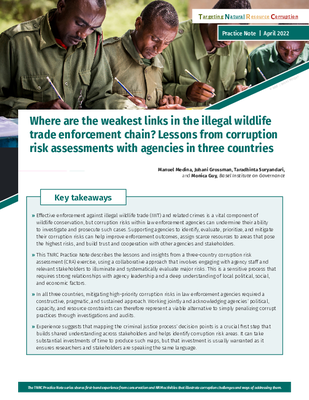Where are the weakest links in the illegal wildlife trade enforcement chain? Lessons from corruption risk assessments with agencies in three countries
This note has a dual focus. First, it summarizes experiences and lessons from conducting CRAs with authorities responsible for investigations and prosecutions of IWT cases in three countries in Africa and Latin America. It seeks to demonstrate the value of adopting a collaborative approach to CRAs, illustrates potential avenues for pursuing such an approach when the right factors are in place, and demonstrates how mapping the criminal justice process provides a solid starting point to identify critical vulnerabilities.
https://biodiversitylinks.org/projects/current-global-projects/tnrc/resources/9a0rqoel09_cra_iwt.pdf/view
https://biodiversitylinks.org/projects/current-global-projects/tnrc/resources/9a0rqoel09_cra_iwt.pdf/@@download/image/image.png
File
Where are the weakest links in the illegal wildlife trade enforcement chain? Lessons from corruption risk assessments with agencies in three countries
This note has a dual focus. First, it summarizes experiences and lessons from conducting CRAs with authorities responsible for investigations and prosecutions of IWT cases in three countries in Africa and Latin America. It seeks to demonstrate the value of adopting a collaborative approach to CRAs, illustrates potential avenues for pursuing such an approach when the right factors are in place, and demonstrates how mapping the criminal justice process provides a solid starting point to identify critical vulnerabilities.



